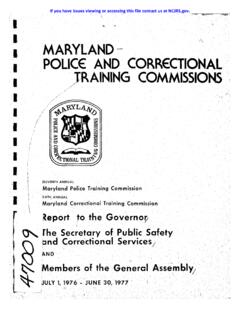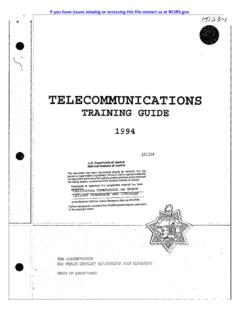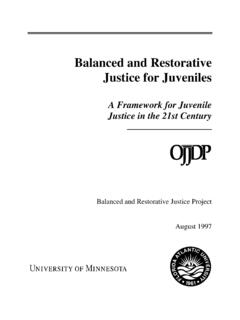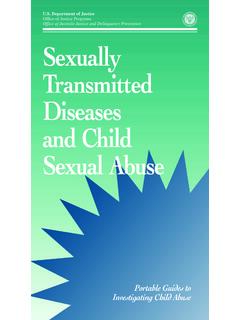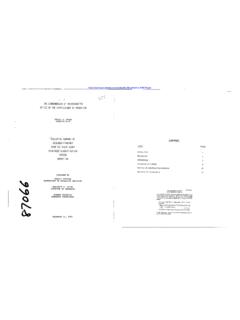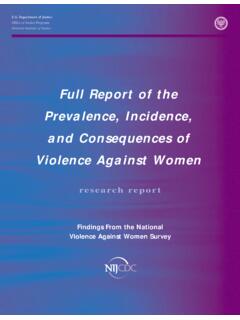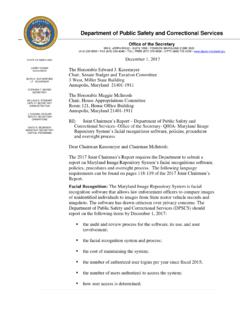Transcription of ~ARYlAND POLICE CORRECTIONAL TRAINING …
1 Department of Public Safety and CORRECTIONAL Services ~ARYlAND --~----\ POLICE CORRECTIONAL TRAINING COMMISSIONS NCiRS ~, AUG 12 i987 ~EPORT -~ ____ ._ . __ ~R 1986 If you have issues viewing or accessing this file contact us at , . Department of Justice National Institute of Justice 106972 This document has been reproduced exactly as received from the person or organization originating It. Points of view or opinions stated in this document are those of the authors and do not necessarily represent the official position or policies of the National Institute of Justice. Permission to reproduce this copyrighted material has been granted by Maryland Department of Public Safety and CORRECTIONAL Services to the National Criminal Justice Reference Service (NCJRS). Further reproduction outside of the NCJRS system requires permis-sion of the copyright owner. I STATE OF MARYLAND DEPARTMENT OF PUBLIC SAFETY AND CORRECTIONAL SERVICES FRANK A.
2 HALL, SECRETARY /Ov CALVIN A. LIGHTFOOT CHAIRIoCAN CORRECTIONAL TR:AININO CO",,.USSION POLICE AND CORRECTIONAL TRAINING COMMISSIONS 3085 HERNWOOD ROAD WOODSTOCK. MARYLAND 21163-1099 COL. GEORGE B. BROSAN CHAIRMAN POLICE TRAININC COMMISSION The Honorable Harry Hughes Governor of Maryland AREA CODE 301-442-2700 TTY FOR THE DEAF 486-0677 October 3. 1986 Members of the General Assembly and Mr. Frank A. Hall Secretary Department of Public Safety and CORRECTIONAL Services Ladies and Gentlemen: ' A. SCHUYLER EXECUTIVE DIRECTOR AssIST .. NT EXECUTIVE DIPlt;CTORS DONALD G. HOPKINS TRAINING FRANCIS L. MAN EAR CERTIP'ICATION On behalf of the Maryland POLICE and CORRECTIONAL TRAINING Commissions. we are pleased to present this annual report covering the period from July I. 1985 to June 3D. 1986. Although the Commissions are separate and distinct. both are within the Department of Public Safety and CORRECTIONAL Services; both receive their legal authority from successive sections of Article 41.
3 Both operate under a single budget. and both are served by the same Executive Director and staff. Again in FY86 each Commission was chaired by a person ,~ith the appropriate experience for the Commission he serves. Calvin A. Lightfoot. Deputy Secretary of the Department of Public Safety. was a member of the CORRECTIONAL TRAINING Commission from May 1979 to August 1981 \~hile Warden of the Baltimore City Jail. lle began his career in corrections as a CORRECTIONAL Officer at the jail in 1963. Prior to returning to Maryland in July 1983 to accept his present position. Mr. Lightfoot was the Executive Deputy Commissioner. New York State Department of Corrections. With the retirement of Col. W. T. Travers on November I. 1985. Col. George B. Brosan appointed Superintendent of the Maryland State POLICE and Chairman of the POLICE TRAINING Commission. Col. Brosan has been a law enforcement of-ficer for many years starting as a patrolman in the New York City POLICE Depart-ment and la ter serving as aU.
4 S. Customs agent. Transferring to the Drug Enforcement Administration he has served as the Special Agent-in-Charge of the Baltimore Office and finally as Deputy Assistant Administrator - TRAINING . Federal Lalli Enforcement TRAINING Center. Glynco. Georgia. The Honorable Harry Hughes Members of the General Assembly Mr. Frank A. Hall Page two FY86 was a notably productive year in all respects. While the number of POLICE and CORRECTIONAL officers trained in all programs remained relatively stable, there was a significant increase in the number of CORRECTIONAL instruc-tors trained. Specifically there was a 160% increase in FY86 over FY8S, with the estimated increase in FY87 being 100% + over FY86. This effort was essential to allOl~ CORRECTIONAL in-service TRAINING to be mandated. Also in FY86 the Chairman of each Commission appointed a Long Range Plan-ning Committee to study future directions and goals, and to prioritize expenditure of resources ir.
5 Light of professional growth and development initiatives, tech-nological advances, improved management techniques and innovative operational developments that will enhance the standards of public safety for Maryland's citizens. Both Committees were very active in addressing critical issues during the year. It is of particular note that while the need for annual in-service TRAINING , and first-line supervisor and administrator TRAINING for CORRECTIONAL officers has been recommended for some time, it was not until FY86 that a statewide in-structional delivery system could be developed to the point that these initia-tives can be mru1dated effective Jruluary 1, 1987. Achievement of this goal was made possible by the addition of five federal/State funded instructor positions to the staff which largely relieved State CORRECTIONAL agencies of their in-structor commitments to the TRAINING academy. These positions also allowed the reorganization of the TRAINING Section so that one professional staff position could again be dedicated solely to the support of law enforcement TRAINING .
6 During this year each Commission also recognized that there is little or no TRAINING available within Maryland for POLICE and CORRECTIONAL executives or for TRAINING selected personnel to assume executive level positions. The Commission began planning how to meet this need with existing resources in the short term and are reviewing alternatives to address the long term. Finally we again are indebted to the mrulY State and local CORRECTIONAL and law enforcement agencies for their cooperation and the sharing of their resources so that each Commission could be successful in accomplishing its respective goals. The Commissions will continue to serve the citizens of Maryland through the im-provement of selection and TRAINING standards during the following year. Respectfully yours, &l--~~ Brosan, Chairman Pol'ce TRAINING Commission i (. [: TABLE OF CONTENTS Page Introduction 1 POLICE TRAINING Commission Membership 3 CORRECTIONAL TRAINING Commission Membership 4 Agency Staff 6 TRAINING Directors Advisory Group 7 Services of the POLICE and CORRECTIONAL TRAINING Commissions 8 Agency Publications 11 Budget Report 12 Highlights of the Year's Activities CORRECTIONAL TRAINING Academy Operations 14 Law Enforcement TRAINING Operations 15 CORRECTIONAL In-Service TRAINING 16 CORRECTIONAL Supervisor TRAINING 17 CORRECTIONAL Administrator TRAINING 17 Victim Assistance Program 17 Certification Operations 18 Resource Center Operations 19 Legislation 20 Changes in Rules and Regulations 20 CHARTS Staff Organization Chart Budgeted Appropriation and Actual Expenditures Funding Sources TRAINING Academy Activities Summary Law Enforcement TRAINING Activities Summary Certified Law Enforcement TRAINING Academies 5 12 13 15 16 21 I !)]
7 I ~. INTRODUCT~ON The POLICE TRAINING Commission and the CORRECTIONAL TRAINING Commission are two separate and distinct Commissions under the Department of Public Safety and CORRECTIONAL Services established and regulated by separate sections of Article 41 of the Maryland Annotated Code (Section 70A - POLICE TRAINING and Section 70B - CORRECTIONAL TRAINING ). Both Commissions are vested with the authority to set standards of initial selection and TRAINING at both the entrance-level and at the in-service level, for all governmental (State, county, and municipal) law enforce-ment, security, CORRECTIONAL and parole and probation officers in the State of Maryland, and to otherwise upgrade the professionalism of such officers. Maryland was the 23rd state in the Union to adopt some type of legislation to provide TRAINING on a basis to state, county and municipal law enforce-ment agencies. It was the sixth state to make compliance with law enforcement minimum standards mandatory.
8 It was the first state to mandate CORRECTIONAL train-ing standards on a state-wide basis. These measures ,,,ere responses to the demands of citizens, law enforcement officials and POLICE professional organizations and were, in large measure, enabled by federal aid. ----I Maryland's law, enacted in 1966, had its foundation in 1963, when the Maryland State POLICE circulated a proposed law among POLICE executives in Maryland. Acting upon this proposal the Maryland Chiefs of POLICE Association (MCPA) and the Maryland Law Enforcement Officers, Inc. (MLEO) appointed committees to review this as well as other related proposals. Under the encouragement of Attorney General Thomas B. Finan, these committees continued to meet through 1965. From this preliminary work a draft law was completed in October, 1965 and circulated to all Chiefs of POLICE in Maryland. A measure of the general level of support for this legislation was afforded by the total lack of dissent and later ratification of the final draft by the general memberships of both MCPA and MLEO.
9 With wide public and professional support, the 1I~linimum Standards TRAINING Act for Maryland POLICE " was enacted and signed into law by Governor J. Millard Tawes on April 22, 1966. The CORRECTIONAL TRAINING Act, the result of a call for improved selection and TRAINING standards by local jail administrations and managers in the State's Division of Correction, was introduced in the 1970 session of the General Assembly. It was referred to the CORRECTIONAL Administration Committee of the Legislative Council. That Committee recommended revisions to administratively merge the proposed Correc-tional TRAINING Co~nission with the POLICE TRAINING Commission under a single staff. It was this revised plan that was approved by the legislature and enacted into law on April 29, 1971. The factors present in 1963 and 1971 are present today. The demands on law enforcement and CORRECTIONAL personnel continue to increase; the need for TRAINING is more important than ever and the need for selection standards even more funda-mental.
10 -1-It is the purpose of this Agency and the Commissions it serves to continually evaluate the requirements of law enforcement and corrections, to propose changes, to instruct, to provide material assistance and to monitor TRAINING to enable lal~ enforcement and CORRECTIONAL officers and agencies to better serve the public they are sworn to protect, -2- POLICE TRAINING COMMISSI'ON MEMBERSHIP Col. W. T. Travers, Chairman (to September 1985) Superintendent, Maryland State POLICE Col. George B. Brosan, Chairman Superintendent, Maryland State POLICE Calvin A. Lightfoot Deputy Secretary, Department of Public Safety and CORRECTIONAL Services Stephen H. Sachs Attorney General of the State of Maryland Represented by Emory A. Plitt, Jr., Assistant Attorney General Dana E. Caro Agent-in-Charge, Federal Bureau of Investigation, Baltimore Office Bishop L. Robinson Commissioner, Baltimore POLICE Department Represented by Major Patrick L. Bradley Dr.
